Putting the smart in your practice
What does smart technology mean to your practice? We explore how smart technology can facilitate automation and clinical technique to bring more “smarts” to everything a practice does.
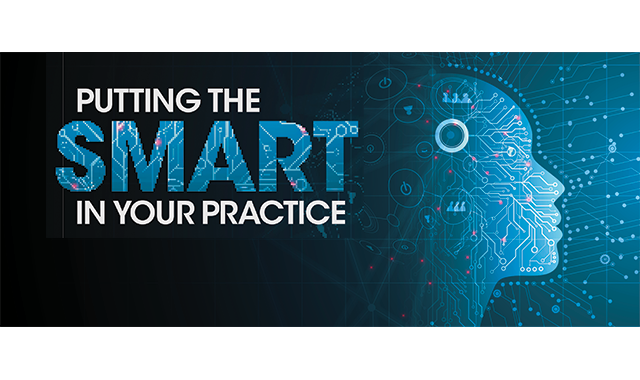
Smart technology is everywhere, from smartphones and smartwatches, to smart TVs and refridgerators. Even thermostats and doorbells have smart technology built in.
“SMART” began as an acronym for Self-Monitoring, Analysis and Reporting Technology. Today, most people think of smart technology as offering consumers interaction and control of things using the internet. One definition says smart technology provides “cognitive awareness” to inanimate objects through artificial intelligence (AI), machine learning, and big data analysis.
“We live in such a smart world, that as consumers, we’re conditioned to work with technology to make our lives easier. It helped us be better performers. When it comes to the dental practice, we want to have the same thing at work,” says Jessica Wilson, MPH, business development manager for Instrument Management Systems, Hu-Friedy Group.
Smart technology is used to automate mundane tasks in our everyday lives according to Masa Ogata, CEO of Tokuyama Dental America.
“Smart technology is prevalent in every aspect of our private lives from smart lightbulbs to automatic pet feeders. It seems a natural progression for practitioners to want to improve their workplace as well. Smart technology will undoubtedly continue to evolve and simplify the centralization of the dental practice, helping to increase potential revenues while reducing overhead costs,” Ogata says.
Jonathan Bass, content marketing manager for RevenueWell, also believes smart technology will become ubiquitous in the dental practice. He envisions a future where dentists can’t live without it.
“As younger dentists come in and are more used to technology and the different systems, it will be folded into their muscle memory,” Bass says.
“We believe that in the near future ‘smart’ is going to apply to any product that reduces time or effort-in terms of documentation, know-how, troubleshooting, and even worry, and this can be applied to the dental office now,” Heather Trombley, president of DentalEZ, says.
Kyle Stanley, DDS, and chief clinical officer at Pearl says new technology will provide consistency and bring more dentists into the future. It will also take on mundane tasks dentists hate so they can focus on providing dentistry.
“When you think about the stress, the burnout, and suicide rates, it is clear that we feel overwhelmed because we have too much on our plate. If you take the mundane tasks out of running a practice, we can do what we love-creating smiles and changing people’s lives,” Dr. Stanley says.
Either way it’s defined and no matter how it’s used, smart technology has a variety of applications in the dental practice. From management to marketing and communication, the future of dentistry is smart.
Continue reading on the next page...
The benefits of smart technology in the practice
Smart technology is already making an impact in numerous ways. With the automation and integration available today, smart technology and AI are already changing dentistry’s business-as-usual.
Smart technology in the dental practice will mimic the enhancements of our personal lives where technology becomes a multiplier, says Tom McCleskey, general manager of A-dec’s Premium Core Equipment Team. Dentists will have more information in real-time that improve processes.
“Smart technology is a pretty broad term, and it’s saying all of the different devices you’re interacting with can not only receive signals or change the state of different settings, but it also has some processing capability,” McCleskey explains.
“Equipment with microprocessors that can interact inside of a particular system and then with other products in an ‘ecosystem’ is a big trend.”
Smart technology is already making an impact in numerous ways. With the automation and integration available today, smart technology and AI are already changing dentistry’s business-as-usual.
Teledentistry-which uses electronic information, imaging, and communication to provide diagnosis, consultation, and treatment-improves the patient experience during referrals and allows for efficient collaboration, making it more hands-on for the GP in real-time, according to Brant Herman, CEO of MouthWatch. He envisions live video conferencing with the specialist, patient, and treatment coordinators where the GP shares intraoral images and clinical data. Teledentistry also allows the GP more engagement with the patient during and after treatment, elevating the patient relationship.
“So, it’s the provider that they have the relationship with helping guide and increase the case acceptance they’re proposing,” Herman says.
Teledentistry can also facilitate public health dentistry for states that allow it, including community-centered practices, such as screenings at nursing homes and school-based varnish programs that lead patients into brick-and-mortar practices for follow-up care. Herman sees the potential to expand this idea beyond public health.
“We’re seeing more of these programs now where practices are going onsite to an office building and setting up a portable operatory. Hygienists are providing preventive and cosmetic services, like whitening and taking images. Dentists then review the images taken remotely and share the treatment plan with the patient,” Herman says.
Intraoral Dental Camera from MouthWatch. Why it's smart: An affordable option that facilitates teledentistry.
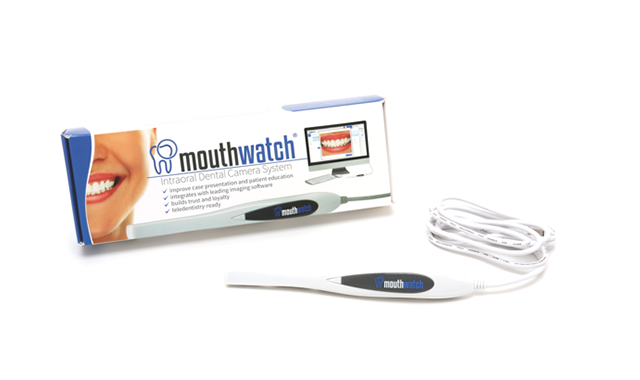
Intraoral Dental Camera from MouthWatch. Why it's smart: An affordable option that facilitates teledentistry.MouthWatch’s turnkey teledentistry product TeleDent recently launched their patient portal with direct patient messaging designed to improve efficiency with delivering care. Also, the dentist can take snapshots during a live consult, which can be saved into a patient record. Plus, it allows for offline work when Internet service is a problem. Moreover, MouthWatch has end-to-end HIPAA compliance.
Teledentistry needs cameras to work, and MouthWatch offers cameras for $299 with an additional discount when purchasing more than one. The company’s goal is to make it possible for every operatory to have a camera whether in traditional private practice, group practice settings, DSOs, and even public health settings.
“We say that intraoral cameras are the starting point to teledentistry, because once practices have the cameras in place, teledentistry can begin. We’ve seen programs thrive by only sending out a hygienist with a laptop and a MouthWatch camera,” Herman says.
Continue reading on the next page...
Smart technology and increased communication
The Internet of Things (IoT) is an often-used phrase that describes every device connected to the internet. But increasingly, IoT has come to specify objects that “talk” to each other. By combining these devices with automated systems, it’s possible to gather and analyze information and create an action based on that analysis. In layman’s terms, these devices are able to communicate with each other and automatically act on that communication.
IoT impacts the dental practice with smart dental devices, according to John Flucke, DDS and Chief Technology editor for DPR. New software can connect devices in the operatory and collect data, including needed maintenance. This connectivity can create efficiencies in the practice.
"Smart technology is prevalent in every aspect of our private lives. It seems a natural progression for practitioners to want to improve their workplace."
-Masa Ogata, CEO, Takuyama Dental America
“If someone can come in and fix a dental chair in the downtime over lunch, you never have downtime in that operatory. It allows us to take advantage of 100 percent of the time potential we have, which is pretty cool,” Dr. Flucke says.
Take Denti.AI, for example-an unbiased cloud-based AI/Machine Learning clinical decision support tool used to identify non pathological and pathological findings on 2D dental radiographs and provides standardization, clarity, and calibration for the dental profession. Their smart chart technology is capable of automated charting for panoramic films. It also helps with communication between dentists, with patients and-in the U.S.-with insurers. Denti.AI offers both an enterprise model and a model for individual offices.
“Our goal is to help great dentists provide great care,” Dr. Eric Pulver, chief dental officer for Denti.AI says.
Jeremy Krell, DMD, MBA, head of marketing at Simplifeye, says technology will improve communication between software. He also predicts more consolidation through acquisition or design, and more multiple-function, one-stop shops improving user experiences for dentistry.
“Everyone should be watching,” Dr. Krell says.
Henry Schein One’s Dentrix Smart Image builds upon the philosophy that everything should to work together as one integrated system. Dentrix has a standardized API with over 250 partners that created integrated solutions. Smart Image is the end of 20 years of silo lockup, or how vendor-chosen relationships ruled dental technology integration, according to Michael Fillmore, Dentrix marketing manager, Henry Schein Practice Solutions.
“The choice of what technology works best in your practice is up to the dentist,” he explains. “It’s our job to make sure that it integrates, that it speaks to each other, and it reduces complexity and extra work.”
However, Fillmore says integration was only the first step. The next step is automation. Smart Image
is the platform for all the imaging systems that exist from all different vendors to deliver them to the patient file automatically.
For example, if a patient needs bitewings, premier vendors with Smart Image will get the imaging system ready to take them. Afterward, it will attach the bitewings to the patient file and automatically generate the CDT codes and post them to the ledger. The system will also note the bitewings in re-care.
“If you’re using our electronic claims services, it automatically attached those correct images with correct codes to the correct claim for you to submit, which takes a lot of work off your plate from a financial and clinical perspective,” Fillmore explains. “All of that is about communicating, and it’s easier to have it all under one roof to make it all communicate together.”
Automated communication technology can free up time to focus on developing personal relationships with patients in the office, according to Clint Berry, CTO of Weave. Smart technology also gives practices insights into business performance and improvement.
“So, I see the impact soon being even more time savings to focus on the most important things in a dental practice and insights that tell dentists how to improve,” Berry says.
DentalEZ understands connectivity and communication with their smart line of products. The AerasTM product line is designed to make it simpler and more efficient to practice dentistry.
“The oral health care professional can focus on what’s really important-great patient outcomes in
an efficient care model,” Trombley says.
Aeras Ramvac compressor from DentalEZ. Why it's smart: It's embedded tech couples with data monitoring for actionable information.
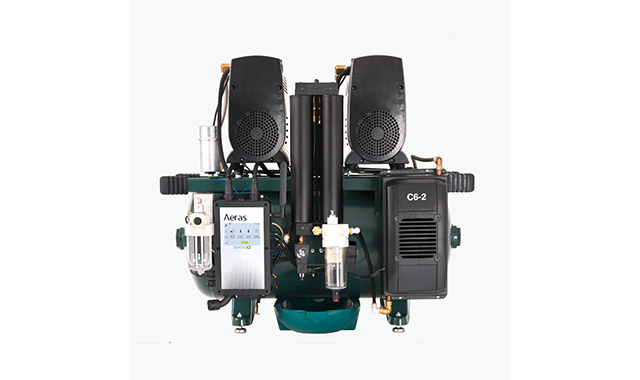
Aeras Ramvac compressor from DentalEZ. Why it's smart: It's embedded tech couples with data monitoring for actionable information.The new Aeras dental compressor has embedded technology coupled with data monitoring that converts operating data into actionable information, such as a text or email. The smart compressor can do things automatically, including scheduling routine maintenance with a service provider.
“The resulting benefits are real and address one of the biggest pain points-unplanned downtime,” Trombley says. “We’ve seen first-hand the reaction by dentists and service providers confirming this; the most common sentiment is, ‘Finally.’”
Moreover, the compressor can be controlled remotely for added convenience.
“No return trip, less time, less worry for the dental practice,” Trombley says of the remote access feature. “That’s smart and it is available now.”
Continue reading on the next page...
Smart technology in the operatory
This technology can help in clinical situations as well. For example, Pearl AI’s second-opinion product will provide consistent diagnoses while reducing the risk of missing something, Dr. Stanley says.
“It’s like having a part-time radiologist with superhuman eyes. It takes the risk out of looking at radiographs by having a built-in AI second opinion over your shoulder,” Dr. Stanley says.
Intelligent software that can flag problem areas on an X ray has two great implications, according to Dr. Flucke. First, it can serve as an impartial third party that educates patients. Second, everyone is prone to miss something, especially when it’s busy in the practice and things are not going as smoothly as you hoped overall.
“It’s easy to make a mistake. It’s easier when you’re under the gun to miss something,” Dr. Flucke says. “It’s just like having another doctor looking over your shoulder and looking at the x-rays and saying, ‘Hey, did you deal with 31? Because that looks like something to me.’”
Pearl AI’s practice management product is a business intelligence tool. Using the second-opinion product, it takes all the data to provide data-driven patient segmentation to help manage their care efficiently. It will also identify if you have enough cases to employ a specialist on staff.
Pearl AI’s Smart Margin can be incorporated with labs and DSOs. It automatically marks and “scores” the margins on intraoral scans. Labs can then route the cases internally based on the scan quality, and practices have unbiased insight into areas of opportunity for staff training.
Tokuyama developed the Smart Materials selection and inventory system to help dentists with productivity. Ogata says, “the idea behind smart materials is to boost productivity for the practitioner by saving time and money.” Their latest composite, OMNICHROMA, addresses this and other pain points in a practice.
“OMNICHROMA is a prime example of a smart material-a single shade of composite that is clinically proven to match the color of any tooth. The newest composite by Tokuyama Dental not only saves the practitioner time from having to shade match their patient, but it also reduces inventory waste,” Ogata explains.
"Dentists didn't come to the industry to be business owners; they came to be dentists. Smart technology will make things more streamlined than it is today."
-Madi Bullock, head of public relations, WEAVE
However, the materials aren’t the only thing in the operatory that has a smart upgrade. For composite restorations, smart technology in curing lights might contribute to the longevity of the restorations compared to using the blue-light LED standard of today, a significant improvement for both the patient and the doctor, according to Nicole Chartier, product manager of Apex Dental Products.
Curing lights haven’t had an update since the blue light LED was introduced, she says. PinkWaveTM Apex Dental Materials latest innovation uses QuadWaveTM Technology, which means the light uses four different wavelengths: UV light, Blue, Red, and Near-Infrared light (NIR) wavelength, which combine to create a Pink light. The QuadWave technology has increased the polymerization microhardness for restorations by 16 percent on the top of the restoration and 23 percent on the bottom, Chartier says. Furthermore, it decreases polymerization shrinkage over the LED blue light by 10 to 15 percent, depending on the composite.
“There will be less marginal staining and pull, so the restoration is going to look better and decrease the chance of secondary caries,” Chartier says.
Continue reading on the next page...
The light has a transilluminator built-in, eliminating the need to buy a second light and saving chair time that dentists previously spent switching between the curing light and transilluminator light. The larger curing capacity of 115mm
2
vs. 107 mm
2
, means the head will cover the entire tooth surface, so clinicians can cover the entire prep in one cure cycle. The PinkWave also increases the curing power without heating up the pulp tissue using the NIR wavelength.
“Since the pulp tissue does not absorb these light waves, we can increase the power wattage without heating the tissue, which is safer for the patient,” Chartier says.
Operatory chairs have upgrades, too. McCleskey was director of product management during the development of the A-dec 500 dental chair, the design of which took into account the challenging physical experience that a dental team experiences daily.
“The new 500 focuses on fostering great ergonomics for the dental team and great integration of all of the technologies at their fingertips with an easy-to-access user interface that allows them on-demand access instruments and change settings without even a second thought,” McCleskey says.
A-dec 500 from A-dec. Why it's smart: Features an easy-access interface combined with great ergonomics, and functions turn off or reset automatically.
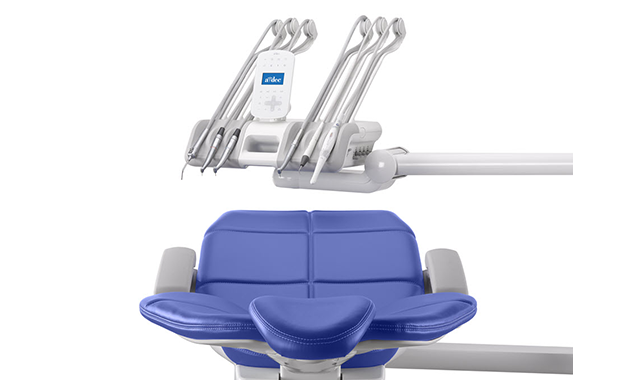
A-dec 500 from A-dec.Why it's smart: Features an easy-access interface combined with great ergonomics, and functions turn off or reset automatically.The design of the 500 is also tolerant of the rate of change of technology, he says. Teams can add technology later that integrates with the system.
“Dentists make a big investment in equipment that they use all day, every day to do their job. They want to have reliable equipment that’s also scalable into the future,” McCleskey says.
The A-dec team also considered repetitive tasks in their design. They have things turn on or reset auto matically so the dental team doesn’t have to think about it. Moreover, it needed to be easy-to-use.
“It has to be something where a dentist can go right to work without a lot of learning curve,” McCleskey says.
The A-dec 500 features a capacitive robust interface and feedback screen that moves into a working position so dentists can access their instruments and see the controls while barely turning their heads. Dentists can look over the top of their loupes and make a quick activation or setting adjustment and go back to work.
“It’s having all of that information right where they need it,” McCle key says.
The organization continues in the operatory with smart systems in place. The ZIRC Color-Method is a comprehensive instrument and materials management system. Each procedure is color-coded with every instrument, tool, and material needed for it and organized by color-specific tubs, trays, instrument holders, and Zirc’s EZ ID rings and tape.
“You’ve got everything you need when you go into the treatment room to help that patient,” says Kay Hickey, product and efficiency consultant for Zirc.
“You are setting yourself up for success the next day. When the team goes in for a procedure, everything is set-up ahead of time and color-coded, making everyone happier, less stressed, and more efficient,” Holly Winn, Marketing Manager for ZIRC says.
The instrument holders eliminate the need to sort through a pile of instruments for cleaning, which is time-consuming and risky for infection control. Zirc’s fiber-filled and anti-microbial resin cassette keeps the instruments together, so they never get misplaced. Plus, the cassettes are more cost-effective than stainless steel cassettes.
“Also, with this color method, having that attractive, organized, colorful look right there, chairside eases patient anxiety,” Winn says.
Another benefit is managing the inventory. Instead of filling four treatment rooms with the same materials, a procedure tub moves from room to room for each procedure, Hickey says. You can see at a glance what’s available, reducing the risk of over-ordering.
“Through the course of my career as a dental assistant before coming to Zirc Dental Products, I’m sure I’ve thrown thousands of dollars away in inventory. This system prevents that from happening,” Hickey says.
Practice management and technology
Many people underestimate how complicated managing the daily activities of a dental practice can be. A lot of prep work goes into processing patients efficiently and smart technology will help.
“There’s probably not a process that won’t be affected in some way by these systems that can communicate one to another,” McCleskey says.
Many ineffectiances in the practice are due to ignorance because staff don’t even realize a problem as it’s become part of the norm, Hickey adds.
“Dentists didn’t come to the industry to be business owners; they came to be dentists,” Madi Bullock, Head of Public Relations for Weave says. “Smart technology will make things more streamlined than it is today.”
Smart technology can help simplify many aspects of practice management, including staffing, compliance training, and handling supply chains.
Continue reading on the next page...
“Many practices are run with a player-coach mentality. However, dentists don’t always have the time to oversee the practice from a perspective of managing chair time, reschedules, optimizing costs for operations, etc.,” says Joe Fogg, CEO of onDiem, a national, on-demand dental staffing firm. “Technology can provide dentists with deep-dive insights into the practice presented in a dashboard to help them maximize their time, so they can treat more patients and provide better care.”
Denti.AI's AI/Machine Learning support tool. Why it's smart: Uses unbiased cloud-based machine learning to identify non-pathological and pathological findings on 2D radiographs.
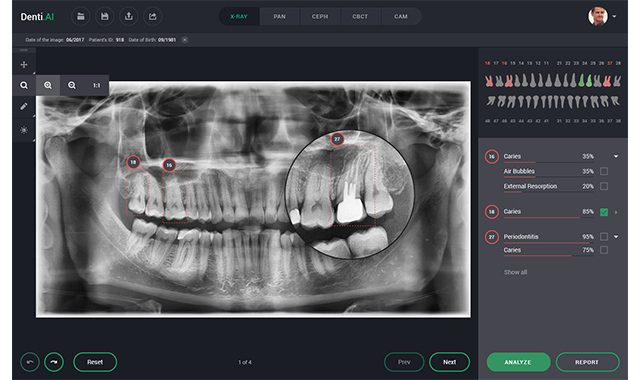
Denti.AI's AI/Machine Learning support tool.Why it's smart: Uses unbiased cloud-based machine learning to identify non-pathological and pathological findings on 2D radiographs.Smart technology will take hold in dentistry because of its cost-efficiency, says RevenueWell’s Bass. The return on investment (ROI) reverts to the stakeholders’ pockets faster than other technology investments, like CEREC systems or some laser technology.
“Our technology is a couple hundred dollars a month. Practices pay off the monthly fee in two days,” Bass says. “And the work we’re doing now shows the old-guard how to boost revenue to give themselves a better forecast when they want to sell.”
Smart technology has the ability to streamline patients’ time in the chair, allowing dentists to see more patients and improve practice revenue, according to Chartier.
This technology has also emerged to help drive down the cost of supplies. Dr. Scott Drucker, co-founder and president of Supply Clinic says they are excited to move supply procurement into the digital era.
“Our online marketplace lets sellers compete for dentists’ business, meaning that dentists see the benefits of their collective bargaining power,” Dr. Drucker says.
Supply Clinic is a transparent online marketplace where practices shop and buy from multiple sources on a single checkout. Then, suppliers ship directly to the customer. Supply Clinic has over 130 sellers listing over $75,000 products.
Continue reading on the next page...
Supply Clinic was designed to help provide adequate tools for managing purchasing across multiple offices. The team built these tools to help dentists with more than one location manage their supply spending. The company reports prices are 33 percent lower, which translates to dentists saving over $16,000 per year.
"Many practices are run with a player-coach mentality. Dentists don't always have the time to oversee the practice from a perspective of managing chair time or optimizing costs."
-Joe Fogg, CEO, onDeim
Supply Clinic has also beta tested a software system called The Enterprise Suite for dental chains. This suite provides corporate oversite and approval of purchase orders; KPI reporting and budgeting on a per-location basis; formulary pricing and restrictions; and seamless integration with the Supply Clinic Marketplace.
“Distributors today don’t typically provide adequate tools for managing purchasing across multiple offices and we can help solve this pain point for practices,” Dr. Drucker explains. “As dental practices increasingly shop online, distributors won’t be able to get away with charging hidden prices to different doctors. Marketplaces like Supply Clinic let sellers compete against each other with clear, visible prices, meaning dental practices know exactly what market rates are for various products.”
Staffing is another area where smart technology has already made an impact. OnDiem is neither a job board nor a temporary agency. The dental professionals on the platform serve as their float team for shift management. Practices should leverage onDiem to manage payroll expenses based on patient demand, much like how manufacturing companies manage inventory in the warehouse, according to Fogg.
“Manufacturing companies will do inventory based on minimum and maximum on re-orders. We can complement a practice or grow with extra days to the schedule and open new chairs when they have an excess of demand,” he explains.
OnDiem handles the onboarding of dental staff on behalf of the practice, managing the working interview, license verification, payroll, benefits, and more. OnDiem also matches talent to the practice. Iconography highlights different information, such as background, CE credits, and credentials, among others. Their system works with a mixture of AI and algorithms.
“Some people confuse AI with algorithms. We use different algorithms for matches and use AI to maximize shift fulfillment. AI is constantly evolving the algorithms based on user behavior. Through the combination of algorithms and AI, onDiem will be excellent for candidate sourcing and shift fulfillment,” Fogg says.
Optimizing compliance is another way that smart technology is bringing an analog part of the practice into a digital world, says Hu-Friedy’s Wilson. The GreenLight Dental Compliance CenterTM by Hu-Friedy brings the procedures and protocols for the Centers for Disease Control, state dental boards, and OSHA online into a digital compliance management portal. The Compliance Center also provides practices an easy way to develop their written protocols manual as required by the CDC.
Continue reading on the next page...
“Essentially, we’re trying to take the burden out of maintaining compliance,” Wilson says.
The portal took two years to develop, in part because state dental associations don’t have protocols already compiled. With the GreenLight Dental Compliance Center, a practice can fill out a questionnaire and submit it. Then, the product creates a compliance manual customized by state in an hour. Wilson says the portal is a huge benefit to group practices because they can manage compliance for multiple sites, as opposed to having a team member have to check compliance physically, which may only happen in-person once a year. Moreover, the portal provides a dashboard which shows the compliance progress of each location.
“With our portal, it gives them management access at their fingertips on their phone for the metrics that we include,” Wilson says. “We also have recommendations for vetted experts in compliance if they need additional consulting.”
Smart technology also automates part of the patient experience. Bullock says that smart technology makes managing the patient experience fast and effective.
“With Weave, front desk staff not only see that a patient had a cleaning appointment last month, but they can see a balance that is due for that cleaning, which they can then text to the patient,” Bullock explains.
The bottom line
CJ Chuapoco, Product Marketing Manager at Weave, says smart technology also helps small dental practices improve their bottom line.
“We know that features like Text-to-Pay help office managers collect payments more efficiently, but we’ve also seen practices using it in unexpected ways, such as charging missed appointment fees immediately with the press of a button. This all adds up to more Accounts Receivable collected with less time, effort, and hassle,” Chuapoco says.
Dentrix Smart Image from Henry Schein One. Why it's smart: Ability to prepare images, then attach images and CDT codes to the patient's file.
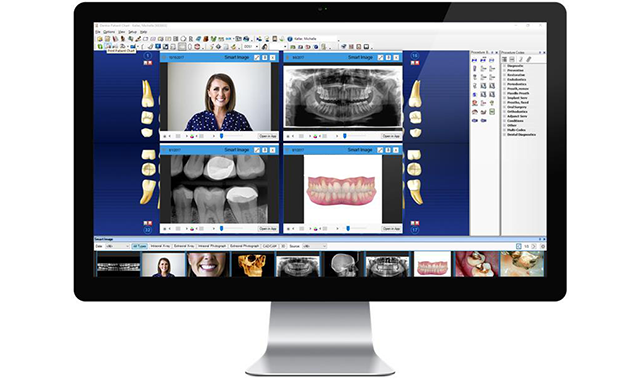
Dentrix Smart Image from Henry Schein One. Why it's smart: Ability to prepare images, then attach images and CDT codes to the patient's file.RevenueWell also helps automate patient follow-up by syncing with the practice management system. It “reads” the dental codes entered and sets automatic reminders based on the patient’s treatment.
“You set it and forget it,” Bass says.
Practices can also automate expiring insurance reminders by segment ing the insurance remaining in the account and setting the program to send a reminder postcard, he explains.
RevenueWell also facilitates digital forms so staff can take care of administrative tasks before the appointment, which reduces wait times and moves patients through the practice efficiently. Also, fewer no-shows occur when people have invested their time in completing the paperwork.
“Both sides like the expediency,” Bass says.
Smart technology also protects the integrity of Accounts Receivable. Pearl AI’s insurance products use a subset of AI that allows computer vision, which prevents fraud by detecting potentially fraudulent claims in x-ray images. While the percentage of dentists attempting to defraud patients and insurance is small, Dr. Stanley favors a zero-tolerance policy.
Computer vision also streamlines claims approval in real-time. Dental teams can upload to the Pearl AI portal for instant approvals or denials. The patient in the chair can also get an accurate estimate for what they will pay while they are still at the practice.
“We want to bring transparency to every aspect of the dental world,” Dr. Stanley says. “I hope that these products will allow the dentist to have less stress in their lives.”
Continue reading on the next page...
Smart marketing
Tony McGinnis, EVP of Internet Marketing for Scorpion defines smart technology as a set of algorithms performing tasks and making decisions based on actual evidence, giving us quick access to information.
In particular, McGinnis believes Smart marketing technology can optimize a practice’s marketing spend. Smart technology and machine learning can make efficient use of marketing budgets, leading to an improved patient experience because practices are engaging appropriately with the most ideal patients. Evidence-based decisions on marketing spend leads to more patients and positively impacts revenue. Moreover, practices can continue to spend money on marketing initiatives that positively impact revenue and stop spending on initiatives they do not.
“The impact of evidence-based decision making is enormous” McGinnis explains. “And most dental practices are not taking advantage of it.”
A patient’s process of choosing a healthcare provider is complex and spread across multiple channels and devices, according to McGinnis. Scorpion’s system collects continuous data from many practices’ campaigns happening nationwide to determine the best time, place, channel, and device for capturing patients during the buying process. The machine learning technology optimizes advertising spend automatically by presenting the potential patient the right message at the right time.
“The campaigns we manage for our clients are more data-driven, as we’re basing decisions on tens of thousands of ideal customers,” McGinnis says.
Simplifeye’s flagship product Amplify captures prospective patients on the practice website. About 45 percent of patients shop for a dental provider after hours, Dr. Krell says. Amplify’s 24/7 live-chat feature is HIPAA compliant and ensures practices capture online leads, even on nights and weekends. Moreover, the email response time for Amplify is faster than average-seven seconds vs. 17 hours, respectively.
“Many practices are driving patients through multiple channels to the website, from mailers to billboards, to social media ads, etc.,” Dr. Krell says. “Amplify sits on the website and offers a white-glove customer experience and can schedule directly with Dentrix, EagleSoft, and Open Dental platforms for practice management.”
Amplify is a proven product category for Simplifeye, which works with 6,000 doctors. Dr. Krell says a practice usually gets six to ten new patients a month over what they often did previously.
“We have sent over 195,000 referrals and engaged in 480,000 patient conversations (via chat), generating over $400 million in patient value,” Dr. Krell says, adding that the product is “the most economical assistant you will ever have.”
The team is also expanding into high-level revenue cycle management. Dental practices can charge patients for services that cost less and are easier for the patient. Also, they will facilitate automatic payment plans for credit and debit cards and ACH payments.
“Now, the practice is not relying on the patient to send a check, nor do they have an office manager call on a schedule and get the credit card for payment. The payments happen automatically,” Dr. Krell explains.
"It's going to be essential for practices to find a way to incorporate technology into their workflow that enhances the level of communication with patients."
-Brant Herman, CEO, MouthWatch
Traditional marketing is hard to measure, Bass says. A billboard, for instance, might have an estimated number of eyes that see it, but no measurement of how that translates to ROI. With RevenueWell patient communications automation, practices can see how many emails were sent and how many appointments they generated.
“The bottom line is there is a more efficient way to get people in the practice, measure what your return is going to be, see what works and doesn’t, and gauge results in real-time,” Bass says.
Continue reading on the next page...
The smart tech future
McCleskey says the power of connected systems and information can improve dentistry. However, when new technologies are introduced, it should not create noise and confusion, but address pain points doctors feel every day. Moreover, once smart devices connect inside a clinic, the next step is connecting all of that equipment have across multiple locations, which McCleskey says opens up a “whole new frontier for data gathering.”
“Of course, the real challenge is to convert data into real information that gives you actionable direction on what would be a good way to solve the problem,” McCleskey says.
The connections will continue throughout the people involved in dentistry also, Wilson says. Specifically, it will unite a community of experts on infection control in and out of the practice for shared knowledge and expertise.
“Technology will unify the community of infection control, and not only for dental practitioners, but also manufacturers and dealers where there is a lot of opportunity for integration because infection control is interdependent on other things in the office,” Wilson says.
Dentrix sees the future will facilitate the combination of software and hardware in the operatory-the chair, imaging systems, Mill, and 3D printer will communicate.
“So again, one brain, one back-bone for a lot of the technology in your office to work together to accomplish more,” Fillmore says.
Fillmore also sees Dentrix simplifying the insurance process from end-to-end and he predicts that dentistry will see more advanced remote presentation and patient education software and techniques. In addition, predictive analytics will work further into dentistry, from analyzing brushing techniques to biosensor indicators, he says.
“It will help predict what’s going to happen and what kind of procedures and care the patient may need in the future,” Fillmore says.
Simplifeye's Amplify. Why it's smart: Features 24/7 live-chat and responds to emails in about seven seconds.
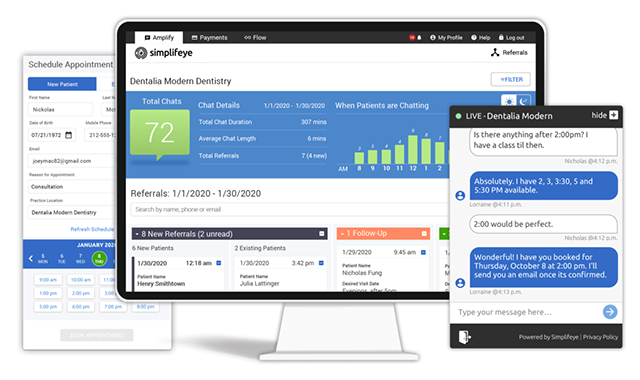
Simplifeye's Amplify.Why it's smart: Features 24/7 live-chat and responds to emails in about seven seconds.DentalEZ has a full roadmap over the next several years that builds out their smart line and incorporates more products. Each incrementally improves some aspect of the practice of dentistry.
“When woven together, they will create a suite of connected products that allows modern practices to refine its processes to save time and money, all while advancing the standard of care,” Trombley says.
The future of smart technology will be consolidation according to Bass. All of the patient communications are going to roll into one and work together while raising practice to patient expectations. Also, the marketing will segment more as practices dial in and get granular about it.
“People expect things a lot quicker, so we are expected to click off more tasks in one day. Smart technology helps people streamline the day and offloads minutiae,” Bass says.
Automating inventory management could be on the horizon, according to Dr. Flucke. When materials reach the re-order point on the shelf, a system would order it online. Moreover, AI could search for the lowest price available and give dentists choices.
“You could have artificial intelligence that then goes out and looks for whatever that product is for the lowest price available. And then gives you choices. ‘Do you want to order from your local supplier or get it for 20 bucks cheaper here?’” Dr. Flucke says.
Continue reading on the next page...
It’s vital for dental practices to get on the smart technology band-wagon, Bullock says.
“If you are not already tapped into the idea that patients will leave you for a better experience somewhere else, you are behind,” Bullock says.
Chartier says future curing light technology innovations will be centered around improving the restoration and driving a better patient experience.
“Giving the patient a better restoration and making life easier is the priority,” Chartier says. “No one wants to spend a lot of chair time when they can be out doing something else.”
In AI, Dr. Stanley predicts that natural language processing will explode-automating phone calls and scheduling, which optimizes the schedule for productivity. Moreover, Dr. Stanley sees AI making connections with medical health records.
“Smart technology and AI will allow us to make treatment plans for patients based on patient health history, ethnic background, muscles in the face, saliva content, diet, etc. You need an algorithm that uses AI to do research and find these connections,” Dr. Stanley explains.
Dr. Pulver says what Dental.AI has today is only the beginning of what is possible with the technology. His background as an oral and maxillofacial surgeon led to awareness of the impact of oral health on systemic health.
“I see radiographic interpretation as a window into utilizing AI/ML to impact all aspects of care-both oral and systemic,” Dr. Pulver explains. “We believe strongly in the ability of dental professionals to play a significant role in closing the oral systemic health links through this type of innovative technology.”
Zirc sees a future in technology applications that could enhance their system. Specifically, technology could track inventory and facilitate reorders.
“There are ways that we can utilize technology to monitor inventory easier and more efficiently,” Hickey says. “We’re excited to see where it takes us.”
Looking longer term, McGinnis sees machine learning and AI used to drive decision-making for digital marketing spend based on evidence will become the standard for marketing a dental practice. Moreover, he sees that dental practices-large or small-will get left behind if they are not using it.
“Capturing a patient now and developing a relationship now will continue to pay dividends down the road,” McGinnis says. “If you ignore this technology, you are going to fall behind.”
Dr. Krell sees a future where treatment planning or following oral care protocols are facilitated in automatic ways while the patient is in a “dental frame of mind.”
“Having a platform that gets people into the office and offering a way for them to pay for it there opens
up a lot of possibilities for people expanding in the dental space,” Dr. Krell says
AI having the potential for enhancing teledentistry with diagnoses by flagging potential lesions, is something Herman predicts. He also sees a more extensive medical care integration where every healthcare encounter can have a dental component and a referral network ready to address any issues the medical team identifies. Patients will start to expect this level of technology as part of their care, as well.
“It’s going to be essential for practices to find a way to incorporate technology into their workflow that enhances the level of communication with patients but also makes them more efficient in the process,” Herman says.
While all the new smart technology can be overwhelming, it’s important to remember that technology should complement the practice. It should offer functionality and ease of use. With that in mind, the possibilities are endless.
References
“Smart tech” netlingo.com. Web. 25 February 2020. < https://www.netlingo.com/word/smart-tech.php>.
“What is Smart Technology.”www.petra.com. Web. 25 February 2020. <https://www.petra.com/blog/what-is-smart-technology/>.
“What is Smart Technology?”rezaid.co.uk. Web. 25 February 2020. < https://rezaid.co.uk/smart-technology-and-its-benefits/>.
“Facts about Teledentistry.” www.americantele-dentistry.com. Web. 25 February 2020. <https://www.americanteledentistry.org/facts-about-teledentistry/>.
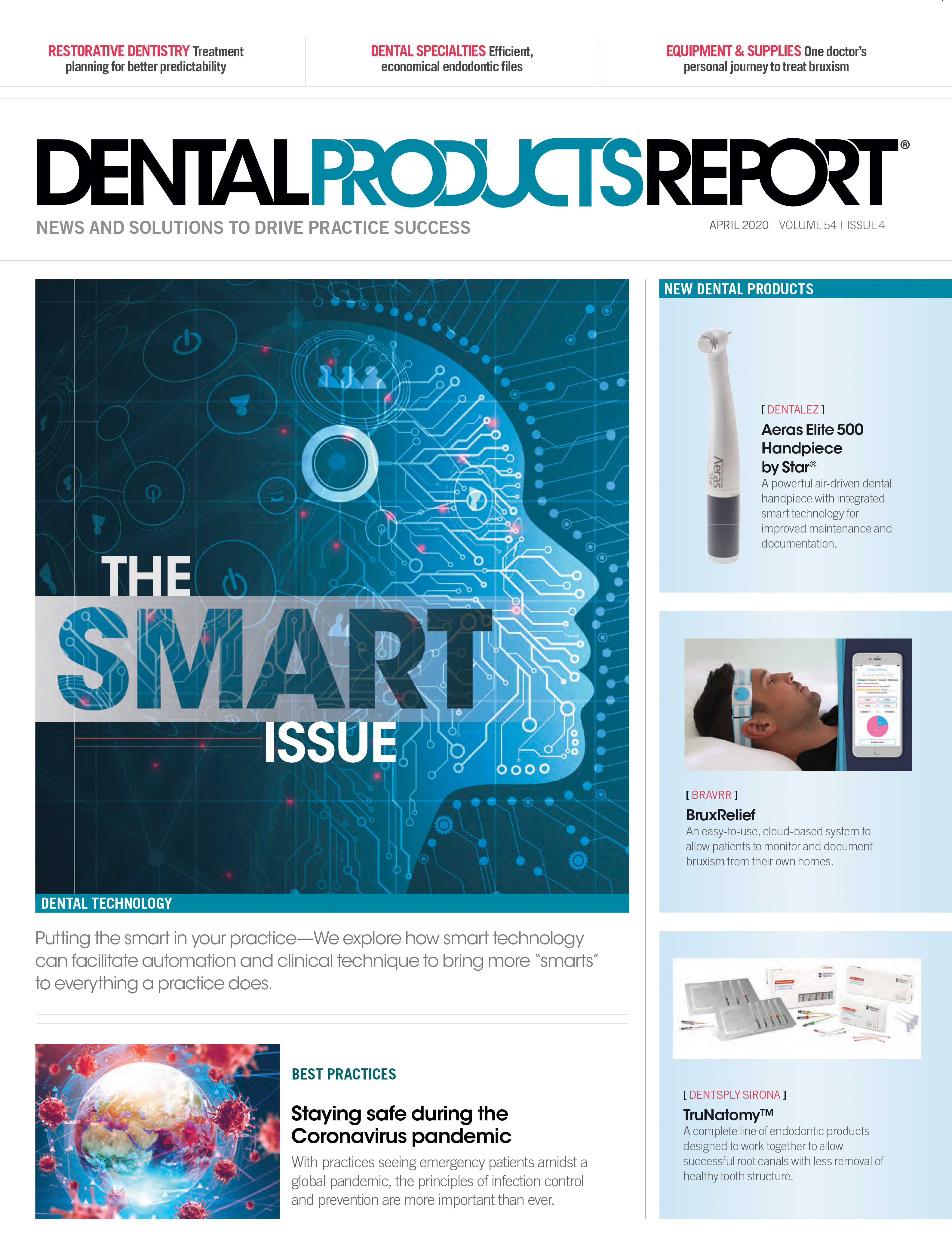
ACTIVA BioACTIVE Bulk Flow Marks Pulpdent’s First Major Product Release in 4 Years
December 12th 2024Next-generation bulk-fill dental restorative raises the standard of care for bulk-fill procedures by providing natural remineralization support, while also overcoming current bulk-fill limitations.